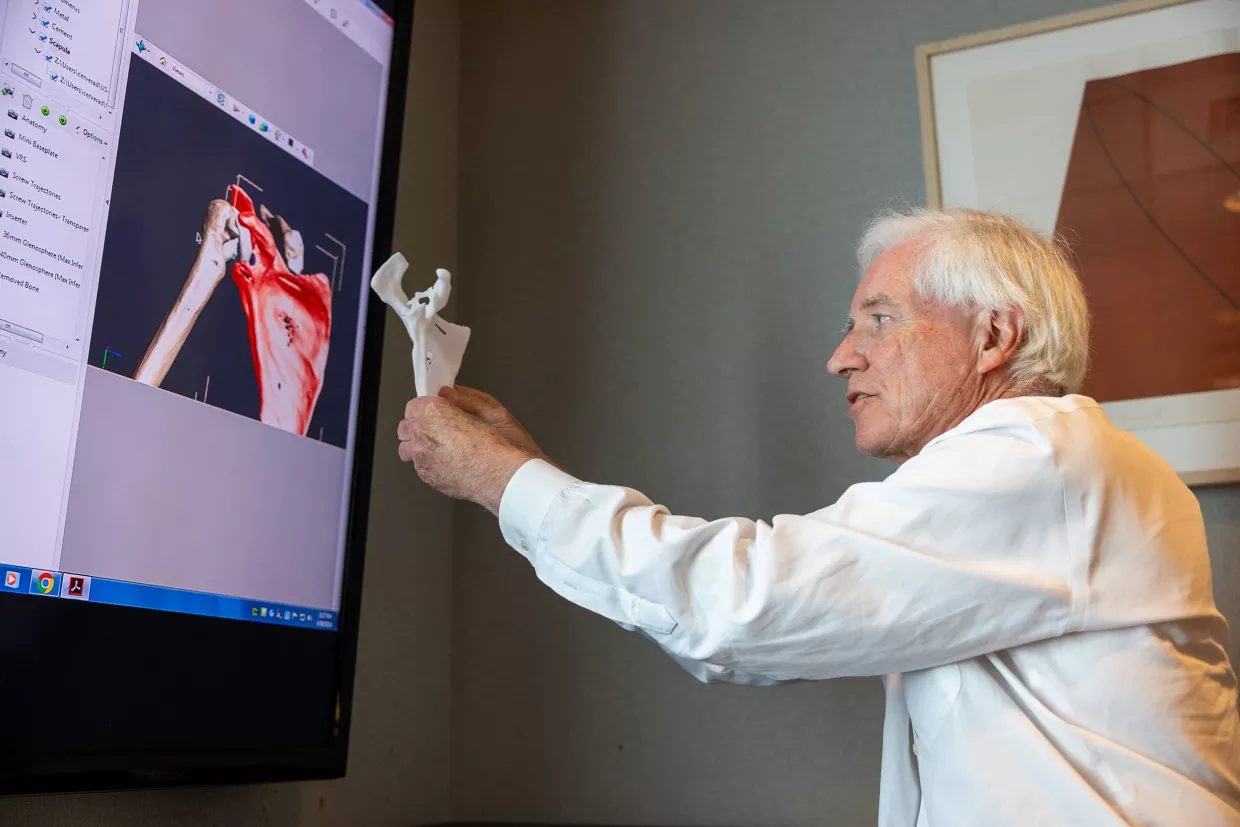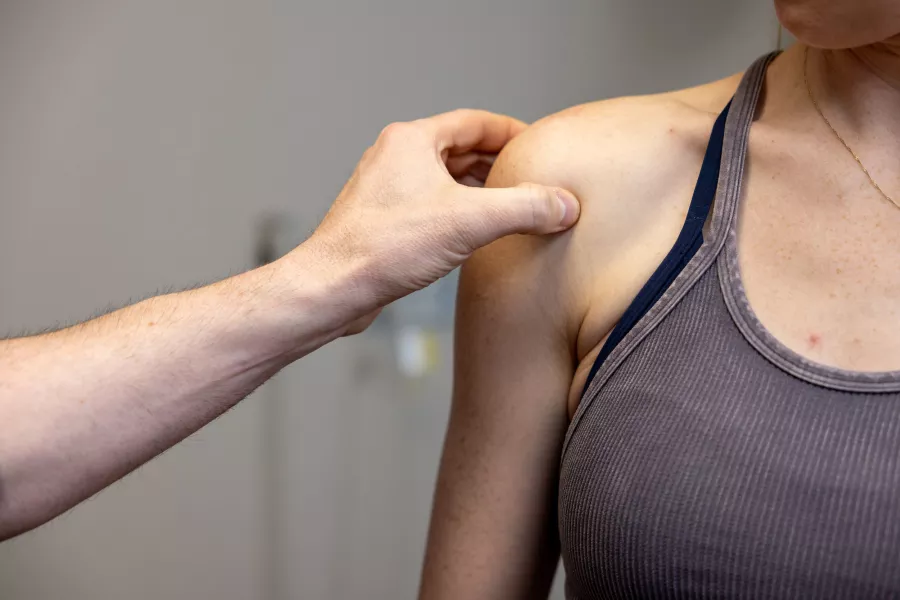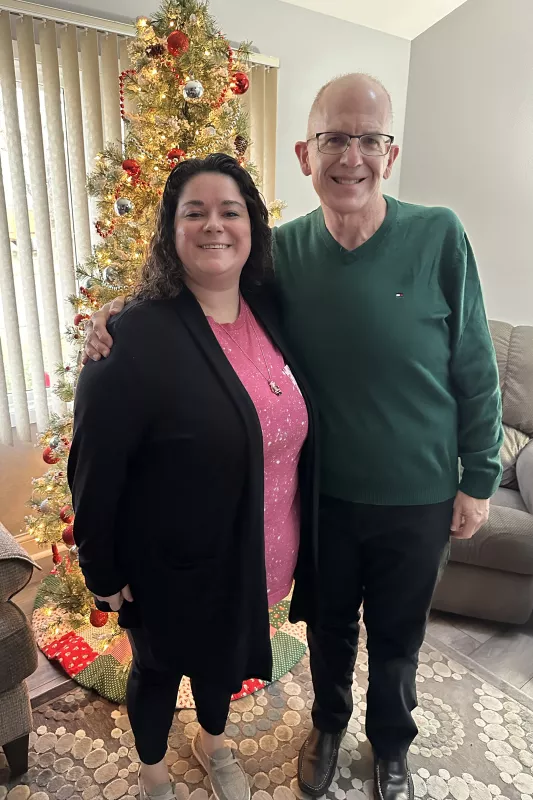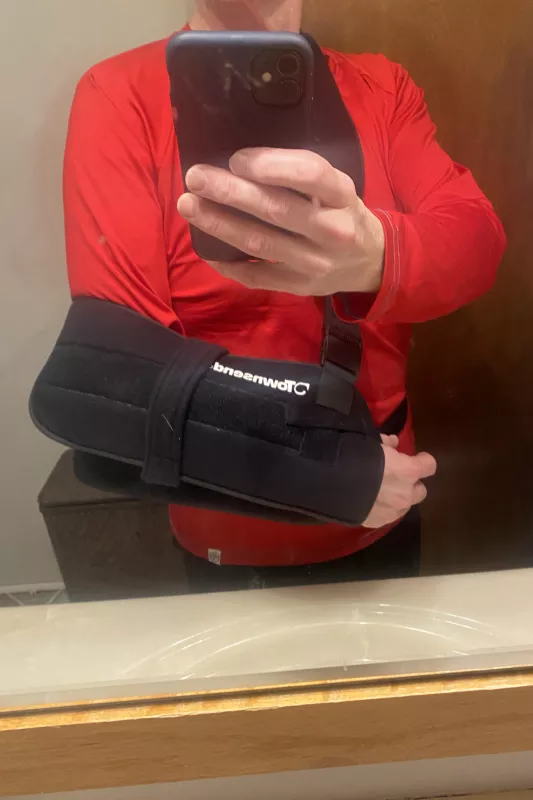Treating shoulder replacement with custom implants
People with severely eroded shoulder bone did not have many options for total shoulder replacement surgery until recent innovations in implant technologies and techniques.

Until recently, University of Iowa Health Care orthopedic surgeon James Nepola, MD, didn’t have options for patients who needed a shoulder replacement but for whom a standard implant wouldn’t work.
But with innovations, Nepola can now offer these shoulder patients a solution—and a pain-free future.
"With custom-made prostheses and modern fixation techniques, we have been able to achieve things we were never able to do before," Nepola says.
That’s made a big difference in Mark Whitfield’s life. More than 20 years ago, Whitfield had two surgeries to treat cancer and needed a titanium implant placed into his shoulder. The implant worked well for many years, but it also altered the appearance of his shoulder.
“I called it my ice cream cone,” says Whitfield, who lives in Des Moines. “My shoulder was rounded at the top and tapered down to fit inside my humerus [upper arm bone].”
As time went on, the ice cream cone appearance became more pronounced.
“I had this ball sticking out of the top of my shoulder, and it moved my shoulder forward quite a bit,” Whitfield says.
Then, in summer 2022, Whitfield’s shoulder pain got worse, so he saw Nepola. Whitfield’s implant had worn through the bone at the top of his shoulder.
“It interfered with my daily life,” Whitfield says. Because of the pain and an inability to use his shoulder, “There were times when I didn’t feel like doing anything,” he says.

Have a nagging joint injury?
Surgery may be the best option to relieve your pain.
When custom-made implants are the best option
Standard implants work well for most people who have run-of-the-mill arthritis and need shoulder replacements.
"People come in similar shapes and sizes, so we have standard procedures and prostheses shaped like normal bone," Nepola says.
However, for less than 5% of patients who need shoulder replacements, the usual prostheses won't work.
"When the bone has been altered because of previous surgeries, tumors, or congenital abnormalities, the bone isn't shaped like a normal bone," Nepola says.
For these individuals, surgeons cannot easily or effectively use off-the-shelf implants, so they tend to put off shoulder replacement surgery because they don't think it's a viable option.
Whitfield was part of this group for a long time. He tried getting a custom implant built around a dozen years ago, but doctors told him there wasn’t enough structure in his shoulder to successfully place an implant.
But Nepola started brainstorming new options after Whitfield’s recent uptick in pain. Nepola ordered a computed tomography (CAT) scan and started working with implant manufacturers to see if new 3D technology could create a custom implant.
“We were excited,” Whitfield says. “My family and I thought this might be a possibility, but we didn’t want to get our hopes up.”
After about a year, Nepola called with the good news: The design for Whitfield’s custom shoulder replacement had been finalized, and the procedure was approved by the insurance company. Following so many years of not having any options, Whitfield was finally getting a new shoulder.
Care that lasts beyond surgery
Nepola has performed about 30 custom shoulder implant procedures, and he carefully explains the potential risks and complications to his patients. Shoulder prostheses wear out with use and time, for example. Also, custom implants might not bond to eroded, compromised bone, although Nepola notes that his patients have not experienced this.
"When you do custom implants, you discuss everything," Nepola says.
Whitfield says he wasn’t apprehensive about the surgery, partly because Nepola explained everything that was going to happen.
“I knew how much Dr. Nepola had done to make sure everything was how we wanted,” Whitfield says. “Going into surgery, I was completely relaxed.”
Here's how a custom shoulder replacement works:
Scans and 3D reconstructions accurately depict the shoulder's bony architecture.
3D printing creates an implant that fits the patient's specific shoulder. The implant's metallic surface closely approximates the typical structure of bone.
During surgery, the surgeon uses a sterile plastic model of the patient's bone and a model of the implant to see how they best fit together—before placing the actual custom prosthesis.
After surgery, the patient's bone grows against the custom implant's bone-like surface, locking the prosthesis into place—a process called osseointegration. This creates a lasting, stable structure.
After the osseointegration period, which takes about six weeks, patients undergo physical therapy.
A brighter outlook after the surgery
Nepola performed Whitfield’s surgery in January 2024.
“When I woke up after surgery, the first thing my wife said to me was to look at my shoulder. I looked at it and almost started crying because I hadn’t had a normal-looking shoulder for 23 years,” Whitfield says.
His family played a significant role in his decision to get the surgery and in helping him through his recovery. That includes one of his daughters, who was at the hospital for the surgery. She was also awed by the immediate difference in Whitfield’s arm.
“I think the most profound thing was that my daughter went to Dr. Nepola and told him that she barely remembered what I looked like before the implant. She was ecstatic,” Whitfield says.


Whitfield’s recovery is going well. While he’s still rehabilitating, Whitfield describes his pain as being the sort of pain that’s good. For instance, he can now raise his arm above his head—something he couldn’t do before.
“I knew I wanted to get back to my normal routine as much as I could,” Whitfield says. “I’m a huge walker, and every day I would walk five miles. I wanted to get back to that, so I would go out and walk the street and come back. I’d keep going out and increasing the distance until I was doing laps around the block.”
Nepola encourages custom-implant patients like Whitfield to remain in touch with his team so he can stay apprised of their condition.
"I say to my patients, 'I'm marrying your shoulder, and we're going to stay together until death do us part. If you have a problem, we have a problem—and we’ll take care of it,'" Nepola says.
Whitfield was so grateful for this level of care throughout the process that he sent a letter of thanks to UI Health Care staff for “how I was treated, how my family was treated, and to just call out the people by names who took care of me,” Whitfield says. “I felt they needed to understand how much this has meant to me and what this has done for my quality of life.”